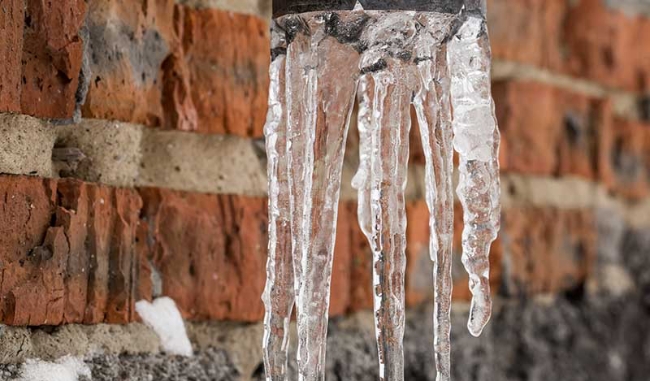Tips for Preventing Frozen Pipes in Cold Weather: Expert Tips
Tips for Preventing Frozen Pipes in Cold Weather: Expert Tips
Blog Article
Just how do you feel about How to Prevent Your Pipes From Freezing?

Cold weather can ruin your pipes, particularly by freezing pipelines. Right here's exactly how to prevent it from taking place and what to do if it does.
Introduction
As temperature levels decrease, the risk of icy pipes boosts, potentially bring about expensive repairs and water damage. Recognizing exactly how to prevent frozen pipelines is essential for home owners in cold environments.
Avoidance Tips
Insulating vulnerable pipes
Cover pipelines in insulation sleeves or make use of warmth tape to shield them from freezing temperatures. Focus on pipes in unheated or outside areas of the home.
Home heating methods
Keep interior areas properly heated, specifically locations with plumbing. Open up closet doors to permit cozy air to circulate around pipelines under sinks.
How to identify icy pipelines
Try to find reduced water flow from faucets, unusual odors or sounds from pipelines, and visible frost on exposed pipes.
Long-Term Solutions
Architectural adjustments
Take into consideration rerouting pipes far from exterior walls or unheated locations. Add additional insulation to attics, basements, and crawl spaces.
Updating insulation
Buy high-quality insulation for pipelines, attic rooms, and walls. Correct insulation aids preserve consistent temperature levels and lowers the danger of frozen pipelines.
Safeguarding Outdoor Pipes
Garden pipes and outdoor taps
Disconnect and drain pipes garden pipes before winter months. Install frost-proof faucets or cover outdoor faucets with shielded caps.
Comprehending Icy Pipelines
What causes pipelines to ice up?
Pipes freeze when subjected to temperature levels below 32 ° F (0 ° C) for prolonged durations. As water inside the pipelines freezes, it increases, putting pressure on the pipeline walls and possibly triggering them to burst.
Threats and problems
Icy pipes can lead to water interruptions, residential property damages, and costly repair work. Ruptured pipelines can flood homes and create comprehensive architectural damages.
Indicators of Frozen Piping
Recognizing icy pipelines early can prevent them from rupturing.
What to Do If Your Pipelines Freeze
Immediate actions to take
If you think frozen pipes, keep taps open to soothe pressure as the ice thaws. Make use of a hairdryer or towels soaked in warm water to thaw pipelines slowly.
Final thought
Stopping icy pipes calls for proactive measures and fast reactions. By understanding the causes, indications, and preventive measures, homeowners can safeguard their pipes throughout cold weather.
Helpful Tips to Prevent Frozen Pipes this Winter
UNDERSTANDING THE BASICS: WHY PIPES FREEZE AND WHY IT’S A PROBLEM
Water freezing inside pipes is common during the winter months, but understanding why pipes freeze, and the potential problems it can cause is crucial in preventing such incidents. This section will delve into the basics of why pipes freeze and the associated problems that may arise.
THE SCIENCE BEHIND FROZEN PIPES
When water reaches freezing temperatures, it undergoes a physical transformation and solidifies into ice. This expansion of water as it freezes is the primary reason pipes can burst. As the water inside the pipe freezes, it expands, creating immense pressure on the walls. If the pressure becomes too great, the pipe can crack or rupture, leading to leaks and water damage.
FACTORS THAT CONTRIBUTE TO PIPE FREEZING
Low Temperatures: Extremely cold weather, especially below freezing, increases the risk of pipes freezing. Uninsulated or Poorly Insulated Pipes: Pipes located in unheated areas, such as basements, crawl spaces, or attics, are more prone to freezing. Insufficient insulation or lack of insulation altogether exacerbates the problem. Exterior Wall Exposure: Pipes running along exterior walls are susceptible to freezing as they encounter colder temperatures outside. Lack of Heating or Temperature Regulation: Inadequate heating or inconsistent temperature control in your home can contribute to frozen pipes. PROBLEMS CAUSED BY FROZEN PIPES
- Pipe Bursting: As mentioned earlier, the expansion of water as it freezes can cause pipes to burst, resulting in significant water damage.
- Water Damage: When pipes burst, it can lead to flooding and water damage to your property, including walls, ceilings, flooring, and personal belongings.
- Structural Damage: Prolonged exposure to water from burst pipes can compromise the structural integrity of your home, leading to costly repairs.
- Mold and Mildew Growth: Excess moisture from water damage can create a favorable environment for mold and mildew growth, posing health risks to occupants.
- Disrupted Water Supply: Frozen pipes can also result in a complete or partial loss of water supply until the issue is resolved.
WHY CERTAIN PIPES ARE MORE PRONE TO FREEZING
- Location: Pipes located in unheated or poorly insulated areas, such as basements, crawl spaces, attics, or exterior walls, are at higher risk of freezing.
- Exterior Pipes: Outdoor pipes, such as those used for irrigation or exposed plumbing, are particularly vulnerable to freezing as they are directly exposed to the elements.
- Supply Lines: Pipes that carry water from the main water supply into your home, including the main water line, are critical to protect as freezing in these lines can affect your entire plumbing system.
- Underground Pipes: Pipes buried underground, such as those connected to sprinkler systems or outdoor faucets, can be susceptible to freezing if not properly insulated.
https://busybusy.com/blog/helpful-tips-to-prevent-frozen-pipes-this-winter/

I found that write up about 6 Ways to Prevent Frozen Pipes while exploring the internet. You should take the time to distribute this blog entry if you enjoyed reading it. I am grateful for your time. Don't hesitate to come visit our blog back soon.
Or Book Technician Here Report this page